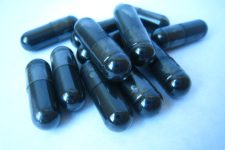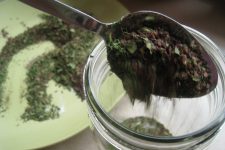
Just as with facial cleansers, a good foundation for healthy skin is the use of astringents and toners.
Their objective is to penetrate and remove all traces of dirt and oil. Likewise, they contract and tighten the pores, and make the skin on our face feel exceptionally clean.
An astringent is basically something that constricts body tissues when applied.
Most often a good astringents are costly — as is the case with most beauty care products and cosmetics — but learn how to make your own and never pay top dollar again!
Herbs with Astringent Properties
Many of our Earth’s plants and herbs possess amazing astringent properties — some of the most common one’s include:
- lemon balm
- chamomile
- rose petals
- elderflowers
- peppermint
- calendula
- comfrey leaf
- witch hazel bark
- lemon and orange peel
- yarrow
- lavender
- rosemary
- sage
Please note: Any of these plant materials can be combined and used in the following recipe — do so based on what you have available.
Herbal Astringent for the Face
Ingredients
-equal parts of: lemon balm, chamomile flowers, rose petals, calendula petals, comfrey leaf, lavender, yarrow, and rosemary
-organic apple cider vinegar to cover
-witch hazel
-essential oils of carrot seed and rose geranium, optional
Method

1. In a quart-sized glass mason jar, combine equal parts of all the herbs you will be using, and based on basic tincturing principles, proceed to prepare the mixture. Note: If using dried herbs, combine equal parts of all of them to total no more than 2 ounces. If using fresh herbs, combine equal parts of all of them to total no more than 4 ounces. Feel free to download and print this How to Make a Tincture at Home pdf file for future reference.
2. Pour organic apple cider vinegar over the herbs until it reaches approximately 2 inches above the plant material.
3. Stir well to combine. Then place a lid on the jar and shake.
4. The jar should rest in a warm place, near a sunny window, and somewhere that allows you to shake it at least once daily (twice is best).
5. Steep for 2-4 weeks.
6. Strain mixture through a cheesecloth-lined, fine mesh sieve. Reserve the herb-infused vinegar and compost the plant material.
7. Combine herb-infused vinegar with equal parts witch hazel and a few drops of essential oils of carrot seed and rose geranium.
8. The astringent will keep in a dark-colored glass bottle or clear glass in a cool, dark place for up to a year.
9. Label each bottle with the name, date, and contents.
10. Use as you would any commercially-prepared astringent product.
Note: I recommend purchasing all of your organic dried herbs from Mountain Rose Herbs and/or The Bulk Herb Store.
Not up for another DIY? Please check out my listing for this Herbal Astringent by clicking this link to my little Etsy Shop.





this sounds terrific! I use organic apple cider vinegar mixed with water but i can see how the properties would make it so much better! THANKS!
I will be pinning this recipe! Thanks for posting and sharing a great natural astringent…!
livininthegreen.blogspot.com
I made lavender oil last summer, could I use that instead of the rose?
Love you herbal tutorials!
Thanks for the recipe! I’ve been trying all kinds of washes to help with my acne and (surprise!) the natural ones seem to work the best. Look forward to trying this one 🙂
I have never used astringent before. I use facial cleanser and toner daily.how often and exactly how do you apply this?
Partilhei com meus leitores a receita e o seu blog. Amo e experimento todas as suas receitas. Obrigada pelo belo trabalho.
Making now!!!! So excited!! 🙂
How do you keep the slime (mother) in the organic apple cider vinegar out of the mix? I work quite a bit with the stuff, and this is a constant battle. Even if the tiniest bit gets in the solution, the yeasts, etc continue to replicate. Are you talking about the unpasteurized, clarified organic apple cider vinegar?
*pasturized not unpasturized
Fannie Mae is made in 1938 as President Franklin Roosevelt’s New Deal.
Within the last few years, loads of studies have been performed as it refers to mortgage elimination.
You can also contain the customer fax the opposite estimates onto you
to definitely have a look at.
Can you say what the approximate yield is please?
Jean, the yield is a lot. I got about 3 mason jars worth (not the Jam size but next size up from that)!
Thank you. I just wanted to know where to ship it since I know now to keep producing it
Does the end product have any traces of the apple cider vinegar smell to it?